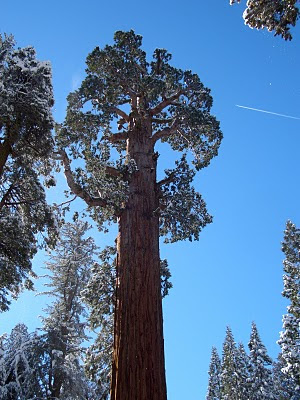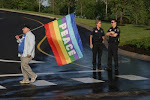
A Sapling at the Birth of Jesus? By Steve Clemens. Feb. 28, 2010
After spending a week of Bible Study on Jesus and Eco-justice (at the Bartimaeus Institute), I made a pilgrimage to one of America’s oldest cathedrals: the stand of giant Sequoia trees in Kings Canyon National Park, about 5 hours northeast of Los Angeles. The Park Rangers estimate the unfortunately named General Grant Tree as being between 1600 and 2000 years old with the nearby larger General Sherman Tree as likely more than 2200 years old. Growing from a sapling which sprouts from a seed the size and shape of an oat flake, these gargantuan trees are more than 40 feet in diameter at their base and often reach into the clouds at their growing altitude of 5000-7000 feet elevation. Weighing an estimated 1,300 + tons, they might serve as a substitute for the amazing mustard seed of Jesus’ parables- something that grows huge from a tiny start.

When 5 or 6 of these behemoth trees grow near each other like they do just a few hundred feet from the General Grant, they form a cathedral as every bit awe inspiring as those built in medieval Europe. Yet it took an act of Congress to make the area the second National Park in the U.S. after hearing the pleas from John Muir to halt the logging of these special trees. Many had already been chopped or sawed down before Congressional action allowed the preservation of the remaining ones to be enjoyed more than 100 years later. It is reported that it took two men 13 days to chop and saw one of these sequoias in order to topple it in the late 1800s.

It was only recently that environmentalists recognized that fire is one of the factors that help these trees grow: the heat from the flames help open the egg-sized and shaped pine cones allowing the seeds to germinate in the soil mixed with ashes. The incredibility thick bark on the Sequoia trunks help shield the trees from most of the fire’s effect although many of the ancient giants show some burn marks around the base of the trees. Some of the fallen trees have had the inside of the tree hollowed out from fire.
I wonder if these trees had not been protected before 1900 if we would bother doing it today. Our capitalism run amuck seems hell-bent on privatizing the Commons and seeking to monetize whatever we can exploit in the natural realm. Maybe naming these two trees after Civil War generals was a stroke of genius – at least our society’s warped values offer respect and deference to conquering warriors. If the trees were named after Walter Rausenbush or Eugene V. Debs, true American giants of the social justice variety, they probably would have fallen to the wood cutters’ axe in the same way as they’ve been chopped out of most U.S. history textbooks.
Our week of Bible Study echoed the phrase, “You can’t save a place you don’t love. You can’t love a place you don’t know. You can’t know a place about which you haven’t learned.” Unfortunately, the giant Sequoia trees of Kings Canyon don’t lie in my home bio-region. But they are a heritage for all of us to appreciate and enjoy. They are worth a pilgrimage if you find yourself in central California.
In the Bible Study we were reminded several times about how important trees are in the Scriptures: Abraham made his first altar under the oak at Shechem. He built another at the Oak of Mamre. We spent a lot of time exploring the role that the Cedars of Lebanon have played in both Biblical and secular history - they were coveted by many empires and rulers, especially King Solomon who used them to build his Temple. The Phoenicians used the cedar to build their ships when they dominated the Mediterranean world. The Assyrian invaders took their war chariots (our present day tanks) up to the hills of Lebanon to secure the theft of this war booty. What once was the crowning glory of Lebanon today is only a small stand of these world-renown trees after 5,000 years of assault. Isaiah the prophet claims that the trees exault with praise after the empires which clear-cut them were defeated. Finally, the last vision in Revelation is the image of the Tree of Life healing all the nations.
Generals Grant and Sherman “earned their stripes” militarily in the Manifest Destiny wars against Mexico and our own Native Americans. They were part of the imperial project which has characterized our nation since its founding. Although our politicians see us as the “last, best hope for the world” (American exceptionalism) the world of nature has experienced us as one of the more prolific destroyers. What an irony to name these sentinels of the forest after a man who burned his way through Georgia during the Civil War and another whose initials came to stand for “unconditional surrender”.
Despite the heavy snow at that elevation last night, coupled with my disappointment at being unable to see the General Sherman Tree yesterday because I didn’t have chains on the tires of my rental car, the Park Rangers were able to plow overnight which allowed me access to the other park entrance this morning. The trees were flocked with heavy snow but those branches just drooped gracefully, occasionally dropping clumps of their white, wet load on those of us worshiping at their bases.

Ched Myers, our Bible Study leader and theological animator,introduced me to his “Grandmother Oak” about 20 minutes from his home in the Ojai Valley on Friday evening. It took four of us linking hands to surround the trunk of this live oak that must be 500-600 years old. Now with these “Grandfather Sequoias”, I’ll need to appropriate the Native American practice of referring to the deity as Grandfather/mother next time I recite the Lord’s Prayer. Certainly the power and compassion of the God Jesus revealed to us is fully present in these gifts of nature. The Apostle Paul reminds us that “all creation is waiting for we humans to take off our masks of domination and co-optation” and join together to both defend, celebrate and stand with it.




No comments:
Post a Comment